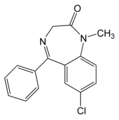Diazepam
Diazepam (marketed under brand names Valium®, Seduxen® and, in Europe, Apozepam® and Diapam®) is a drug which is a benzodiazepine derivative. It possesses anxiolytic, anticonvulsant, sedative and skeletal muscle relaxant properties. more...
History
Diazepam was the second benzodiazepine to be invented by Leo Sternbach around 1960. It is five times more potent than its predecessor, chlordiazepoxide (Librium®), which it quickly overtook when first marketed in 1963. The benzodiazepines gained popularity among medical professionals as an improvement upon barbiturates, which have a comparatively narrow therapeutic index. At first, diazepam was considered something of a "wonder-drug": it was America's top-selling pharmaceutical from 1969 to 1982, with peak sales in 1978 of 2.3 billion pills ($US600 million in sales).
However, it is now known that benzodiazepines carry a risk of dependency. In the autumn of 1973, a report aired on the television show 60 Minutes attesting to the drug's addictiveness. This can occur in as little as four weeks. Following a controversial and often polemic discussion, benzodiazepine prescriptions declined by nearly half in the 1980's and 1990's.
Psychiatrists and neurologists have recently discovered new off-label uses for this 'old' drug, such as adjunctive treatment of extrapyramidal disorders or spastic paresis. This is most likely due to the inhibitory effects of the benzodiazepines (see Pharmacology section below).
Pharmacology
In animal models, diazepam appears to act on areas of the limbic system, thalamus and hypothalamus, inducing anxiolytic effects. It is thought to bind to GABAA receptors, (a sub-type of GABA receptors). Due to the role of diazepam as a GABAminergic agonist, when it binds to GABA receptors it causes inhibitory effects. This arises from the hyperpolarization of the postsynaptic membrane, due to the control exerted over negative chloride ions by GABAA receptors.
Diazepam is redistributed into tissues and fat deposits, where there are similar types of benzodiazepine receptors. In humans, tolerance to the sedative effects may develop within weeks, but tolerance to the anxiolytic effects usually does not develop. Lorazepam, clonazepam and alprazolam show stronger anxiolytic effects compared to diazepam, but carry a higher risk of misuse, abuse, tolerance and dependence.
Pharmacokinetics
Diazepam can be administered orally, intravenously, intramuscularly, or as a suppository. When taken orally, diazepam is rapidly absorbed and shows a fast onset of action. Absorption is much slower and more erratic when diazepam is given as an intramuscular injection. Diazepam is highly lipid-soluble and therefore crosses the blood-brain barrier easily.
Diazepam is metabolised in the liver and has a biphasic half-life. The half-life (t1/2α) is 20-100 hours, and the main active metabolite, desmethyldiazepam, has a half-life of 36-200 hours. Diazepam's other active metabolites include, among others, temazepam and oxazepam. Diazepam and its metabolites are excreted into the urine.
Read more at Wikipedia.org



